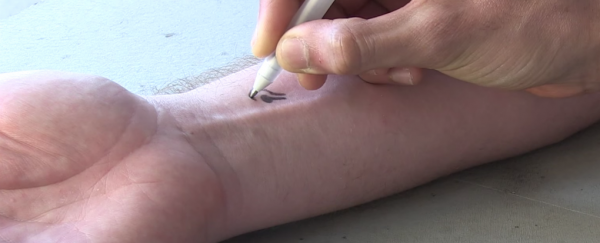Ballpoint pens loaded with sensor-laden inks could eliminate finger pricks for diabetics, and help them test their blood glucose levels simply by drawing cartoons - or just a few dots - on their skin.
The innovative new ink could also be used to test for pollutants in the environment by drawing on leaves or on buildings' surfaces, and could help soldiers search for explosives and chemical weapons, the developers say.
The team of engineers from the University of California, San Diego, who developed the ink, used it to fill up regular, off-the-shelf ballpoint pens. The aim was to enable a new type of do-it-yourself sensor with rapid diagnostic capabilities for people with diabetes.
The ink is made from the enzymes glucose oxidase, which responds to sugar in the blood, and tyrosinase, which can help detect common pollutants known as phenols. These compounds are found in cosmetics and can be toxic at high enough concentrations.
Charles Choi explains for IEEE Spectrum what else was needed to make the inks operate like on-demand sensors: "To make these bio-inks serve as electrodes, they added electrically conductive graphite powder. They also added: chitosan, a clotting agent used in bandages, to help the ink stick to surfaces; xylitol, a sugar substitute, to help stabilize the enzymes during chemical reactions; and biocompatible polyethylene glycol, which is used in several drug delivery applications, to help bind all these ingredients together."
The team has described its "enzymatic ink" and do-it-yourself sensor in the journal Advanced Healthcare Materials.
Using their pens, they were able to draw sensors to measure glucose directly onto the wrist of a willing participant. They say this ink drawing could be "easily interfaced with a Bluetooth-enabled" device that can provide the read-out.
The researchers also used the ink to draw on and measure chemicals on leaves, and according to Choi at IEEE Spectrum, "the inks could be modified to react with many other pollutants, such as heavy metals or pesticides".
The main purpose of the ink, and probably the most immediate impact, will be to enable multiple-use testing strips for diabetes monitoring. As the authors note in their paper, handheld glucose metres rely on single use sensor strips, and each test is expensive for the user.
They demonstrated that when applied to a flexible strip that included an electrode, their ink functioned like a sensor. When a blood drop from a pricked finger was placed on the sensor, the ink reacted and the sensor measured this reaction, accurately determining the blood sugar level.
Importantly, the researchers say their ink only needs to be wiped off for the strip to be re-used - and they say one pen-load has enough ink for 500 tests.
The authors write that the most attractive feature of their pen "is the immense freedom available to incorporate high-fidelity inexpensive sensors of any design on a wide variety of surfaces with minimal user training."
The same team has previously developed temporary tattoos to help diabetics continuously monitor their blood-sugar levels. They say the next step is to connect the sensors wirelessly to monitoring devices and test their performance in different climatic conditions.
Source: IEEE Spectrum
